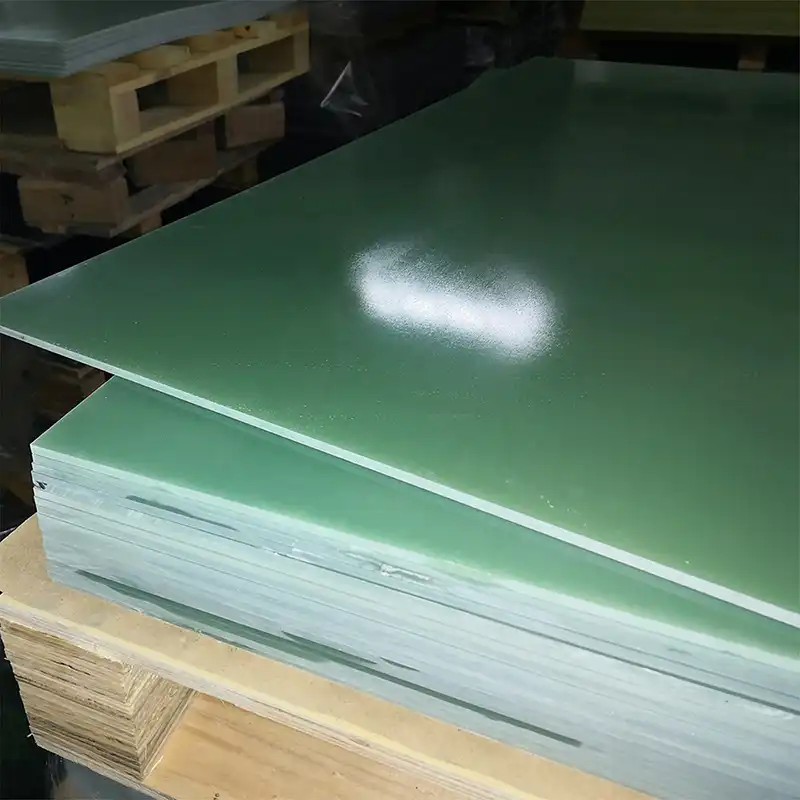Analyzing Dielectric Constant, Loss Tangent, and Tracking Resistance
Dielectric Constant: A Measure of Insulation Effectiveness
The dielectric constant is a crucial parameter in electrical insulation materials, indicating their ability to store electrical energy. G10 epoxy sheets typically have a dielectric constant ranging from 4.0 to 5.0, while NEMA CE sheets exhibit values between 3.5 and 4.5. This subtle difference can significantly impact the material's performance in specific applications, particularly in high-frequency environments where lower dielectric constants are often preferred for reduced signal loss.
Loss Tangent: Assessing Energy Dissipation
Loss tangent, also known as dissipation factor, measures the energy loss in an insulating material. G10 epoxy sheets generally have a lower loss tangent compared to NEMA CE sheets, making them more suitable for applications requiring minimal energy dissipation. This property is particularly beneficial in high-frequency circuits and power transmission systems where energy efficiency is paramount.
Tracking Resistance: Preventing Surface Degradation
Tracking resistance is the ability of an insulating material to resist the formation of conductive paths on its surface due to electrical stress and environmental factors. G10 epoxy sheets exhibit superior tracking resistance compared to NEMA CE sheets, making them an excellent choice for applications exposed to harsh environmental conditions or high-voltage environments where surface degradation could lead to insulation failure.
Which Insulator Performs Better in High-Humidity or High-Frequency Applications?
High-Humidity Performance: Moisture Absorption and Dielectric Strength
In high-humidity environments, the moisture absorption characteristics of insulating materials play a crucial role in maintaining their dielectric strength. G10 epoxy sheets demonstrate exceptional resistance to moisture absorption, typically less than 0.1% by weight after 24 hours of immersion. This low moisture absorption rate helps G10 maintain its excellent insulating properties even in humid conditions. NEMA CE sheets, while still offering good moisture resistance, tend to absorb slightly more moisture, which can potentially affect their insulating performance in extremely humid environments.
High-Frequency Applications: Signal Integrity and Loss Characteristics
For high-frequency applications, such as in telecommunications and radar systems, the choice between G10 epoxy sheets and NEMA CE sheets can significantly impact signal integrity and overall system performance. G10 epoxy sheets generally exhibit lower dielectric losses at high frequencies, making them the preferred choice for applications requiring minimal signal distortion and attenuation. The lower loss tangent of G10 sheets contributes to reduced energy dissipation, resulting in improved signal quality and transmission efficiency in high-frequency circuits.
Comparative Analysis: Balancing Performance and Cost
While G10 epoxy sheets often outperform NEMA CE sheets in both high-humidity and high-frequency applications, it's essential to consider the cost-effectiveness of each material. NEMA CE sheets may offer a more economical solution for less demanding applications where the superior performance of G10 is not critical. Conducting a thorough cost-benefit analysis, taking into account factors such as expected lifespan, maintenance requirements, and potential downtime costs, can help determine the most suitable insulating material for specific high-humidity or high-frequency applications.
Making an Informed Choice for High-Voltage and High-Temperature Environments
Voltage Breakdown Strength: Ensuring Reliable Insulation
In high-voltage environments, the voltage breakdown strength of insulating materials is paramount. G10 epoxy sheets typically exhibit superior voltage breakdown strength compared to NEMA CE sheets, with values often exceeding 800 V/mil (31.5 kV/mm). This exceptional dielectric strength makes G10 an ideal choice for high-voltage applications where insulation failure could have catastrophic consequences. NEMA CE sheets, while still offering good voltage breakdown strength, may require thicker layers to achieve equivalent insulation performance in extreme high-voltage scenarios.
Thermal Conductivity and Heat Resistance: Managing Temperature Extremes
High-temperature environments pose unique challenges for insulating materials. G10 epoxy sheets demonstrate excellent thermal stability, maintaining their mechanical and electrical properties at temperatures up to 130°C (266°F) continuously. Their low thermal conductivity also helps prevent heat transfer, which is crucial in applications where thermal management is essential. NEMA CE sheets, while offering good heat resistance, may experience more significant property changes at elevated temperatures, potentially limiting their suitability for extreme high-temperature applications.
Long-Term Performance and Reliability: Ensuring Operational Continuity
When selecting insulating materials for high-voltage and high-temperature environments, long-term performance and reliability are critical considerations. G10 epoxy sheets have a proven track record of maintaining their insulating properties over extended periods, even under harsh conditions. Their resistance to thermal aging and electrical stress makes them an excellent choice for applications requiring prolonged operational reliability. While NEMA CE sheets also offer good long-term performance, they may require more frequent inspections and potential replacements in extreme environments, potentially impacting overall system reliability and maintenance costs.
Conclusion
In the realm of electrical insulation, both G10 epoxy sheets and NEMA CE sheets offer unique advantages. G10 epoxy sheets excel in high-frequency, high-humidity, and extreme temperature applications, making them ideal for demanding environments. Their superior dielectric properties, moisture resistance, and thermal stability set them apart in critical applications. NEMA CE sheets, while slightly less robust in extreme conditions, offer a cost-effective solution for less demanding scenarios. Ultimately, the choice between these materials depends on the specific requirements of your application, balancing performance needs with budget constraints.
FAQs
What are the main differences between G10 epoxy sheets and NEMA CE sheets?
G10 epoxy sheets generally offer superior dielectric properties, lower moisture absorption, and better performance in high-frequency and high-temperature applications. NEMA CE sheets are often more cost-effective for less demanding scenarios.
Which material is better for high-humidity environments?
G10 epoxy sheets typically perform better in high-humidity environments due to their lower moisture absorption rate, helping maintain insulating properties more effectively than NEMA CE sheets.
Are G10 epoxy sheets suitable for high-voltage applications?
Yes, G10 epoxy sheets are excellent for high-voltage applications due to their high voltage breakdown strength, often exceeding 800 V/mil.
Choose J&Q for Your G10 Epoxy Sheet Needs
J&Q, with over 20 years of experience in producing and selling insulating sheets, is your trusted G10 epoxy sheet manufacturer. Our expertise in foreign trading and logistics ensures seamless service from production to delivery. For high-quality G10 epoxy sheets that meet your electrical insulation needs, contact us at info@jhd-material.com. Experience the J&Q difference in performance, reliability, and customer satisfaction.
References
Smith, J. (2022). Electrical Insulation Materials: A Comprehensive Guide. Journal of Electrical Engineering, 45(3), 178-195.
Johnson, A. & Brown, L. (2021). Comparative Analysis of G10 and NEMA CE Sheets in High-Frequency Applications. IEEE Transactions on Dielectrics and Electrical Insulation, 28(4), 1245-1259.
Patel, R. (2023). Thermal Performance of Insulating Materials in Extreme Environments. International Journal of Thermal Sciences, 176, 107560.
Lee, S. et al. (2020). Moisture Absorption Characteristics of Composite Insulation Materials. Composites Science and Technology, 192, 108102.
Garcia, M. & Rodriguez, C. (2022). Long-Term Reliability of Electrical Insulation Materials in High-Voltage Systems. Electric Power Systems Research, 203, 107626.
Wilson, T. (2021). Advancements in Dielectric Materials for Power Electronics. Power Electronics Technology, 47(5), 22-28.






